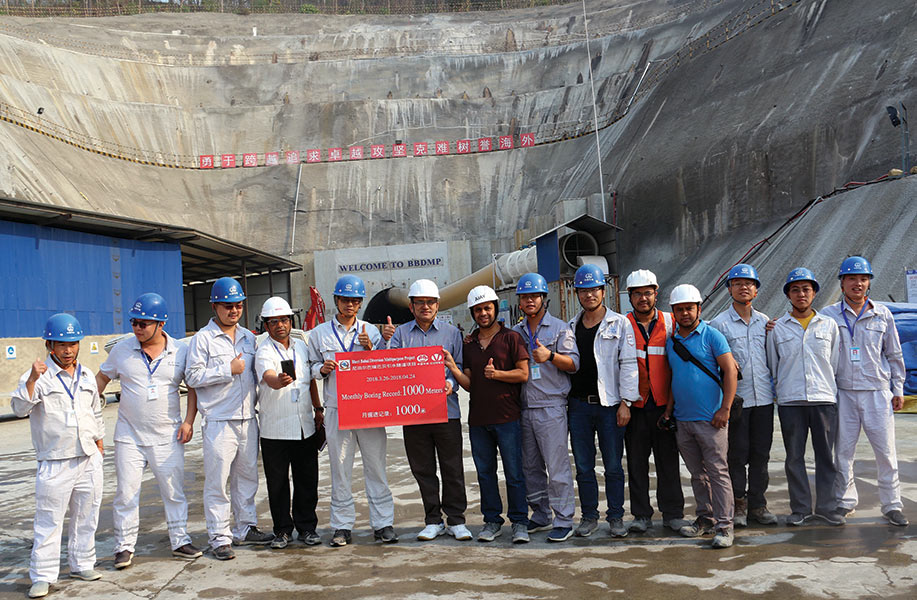Impressive progress for first TBM operation in Nepal 26 Jul 2018
Advance of more than 1,000m in a single month and an average of 800m/month has been recorded by the first TBM to be used in the mountain kingdom of Nepal. After arriving on the jobsite high in the Himalayas in Summer 2017, the 5m diameter Robbins double shield TBM is living up to expectations as it excavates the 12.2km long tunnel for the Bheri Babai water diversion project for contractor COVEC Nepal, the Nepal branch of the China Overseas Engineering Group.
Being advanced by the Government of Nepal Department of Irrigation, the Bheri Babai project is designated as one of 11 National Pride Projects for the Himalayan country. The decision to employ a TBM was a departure for a nation where drill+blast has been the preferred method for previous tunneling projects. Early studies along the tunnel route predicted that drill+blast excavation of the 12.2km tunnel would take nearly 12 years to complete.
With the only possibility of advancing from the downstream portal, the 5m diameter double-shield TBM will complete the 12.2km, erecting a hexagonal precast concrete segmental lining as it advances and using trains of muck cars for muck removal.
The tunnel is located in the Siwalik Range, which is part of the Southern Himalayan Mountains where the geology consists mainly of sandstone, mudstone, and conglomerate.
Several factors have contributed to the good advance rates so far, according to Wang Wu Shui, General Manager for COVEC Nepal. “In China, there is a proverb about TBM construction,” he said: " ‘Geology is the premise, equipment is the foundation, and talents are the key.’ The great advance rates achieved at present mainly lie in preliminary planning, process control, and professional construction personnel.”
Shui added that technical training and guidance has been provided for each position so that all personnel can fully understand their job and team responsibilities. If unforeseen circumstances arise and there is no operator for a certain position, others have enough training to fill the role, he explained.
To ensure the best TBM performance and to prevent downtime, machine maintenance occurs daily at a fixed time. Geological engineers are sent to analyze the ground conditions twice daily so that construction personnel can adjust the tunnelling parameters and prepare for auxiliary measures if geological changes are predicted.
The ground conditions during the record-setting month consisted mainly of sandstone and mudstone, but that is set to change. At about 5.8km into the drive, the TBM will encounter a major 400m to 600m wide fault zone known as the Bheri Thrust. Clay and water ingress is expected throughout the fault reach. COVEC Nepal is prepared for the conditions and has established efficient tunnelling logistics to decrease downtime.
“The two working procedures of tunnel boring and segment installation are carried out simultaneously under the double shield tunnelling mode,” said Shui, “with ring building taking about 15 minutes in general.” To further reduce the cycle time, consolidation grouting is carried out during daily maintenance shifts to avoid the impact of downtime for grouting on the overall construction progress.
Once complete, the Bheri Babai water diversion project will divert 40m3/sec of water from a 15m tall dam on the Bheri River to the Babai River to irrigate 60,000 hectares of land in the southern region of Nepal, and benefit an estimated 30,000 households. Water will flow under a head of 150m to provide year-round irrigation in the surrounding Banke and Bardia districts. The water will also be used to generate hydroelectricity with a generating capacity of 48 MW benefiting the country with NPR 2 billion (US$20 million) annually.
The initial success of the TBM operation has inspired developers and contractors to consider TBMs over conventional excavation for planned and upcoming tunnel projects in Nepal and in the Himalayas.
References
- First TBM for Nepal ready for shipment – TunnelTalk, August 2017
- Geotechnical concerns for deep mountain drives – TunnelTalk, May 2012
|
|
|
|
|
Add your comment
- Thank you for taking the time to share your thoughts and comments. You share in the wider tunnelling community, so please keep your comments smart and civil. Don't attack other readers personally, and keep your language professional.




